Book contents
- Collecting Qualitative Data
- Collecting Qualitative Data
- Copyright page
- Contents
- Figures, Tables and Boxes
- Acknowledgements
- Contributors
- Foreword
- 1 Collecting Textual, Media and Virtual Data in Qualitative Research
- Part I Textual Data Collection
- Part II Media Data Collection
- 6 Making Media Data
- 7 ‘God’s Great Leveller’
- 8 Archives of Everyday Life
- 9 Online Discussion Forums
- Part III Virtual Data Collection
- Afterword
- Glossary
- Index
- References
6 - Making Media Data
An Introduction to Qualitative Media Research
from Part II - Media Data Collection
Published online by Cambridge University Press: 06 October 2017
- Collecting Qualitative Data
- Collecting Qualitative Data
- Copyright page
- Contents
- Figures, Tables and Boxes
- Acknowledgements
- Contributors
- Foreword
- 1 Collecting Textual, Media and Virtual Data in Qualitative Research
- Part I Textual Data Collection
- Part II Media Data Collection
- 6 Making Media Data
- 7 ‘God’s Great Leveller’
- 8 Archives of Everyday Life
- 9 Online Discussion Forums
- Part III Virtual Data Collection
- Afterword
- Glossary
- Index
- References
Summary

- Type
- Chapter
- Information
- Collecting Qualitative DataA Practical Guide to Textual, Media and Virtual Techniques, pp. 117 - 118Publisher: Cambridge University PressPrint publication year: 2017
References
Further Resources: Online
For more information about the ‘Everyday Coupledom’ project, see www.enduringlove.co.uk
The Association of Internet Researchers Ethical guidelines can be found here: http://aoir.org/reports/ethics2.pdf
The ReStore site offers material related to the assessment and development of new methods for the analysis of media content: http://www.restore.ac.uk/lboro/
Further Resources: Readings
References
- 3
- Cited by

